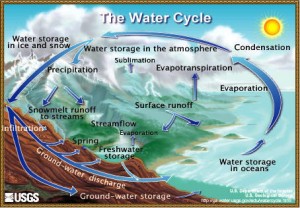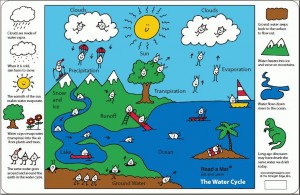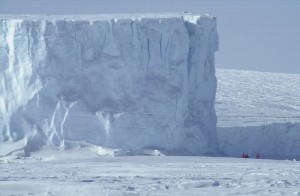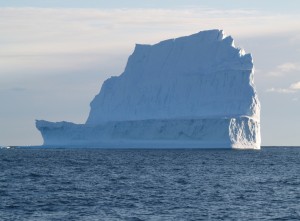The water cycle is ubiquitous in the elementary science curriculum. Students color pictures, read stories, and even learn songs to help them remember the stages of evaporation, condensation, and precipitation. Yet when the Arctic or Antarctica is considered, a simple yet powerful question emerges: What about all that ice?
All photos courtesy of the National Science Foundation.
Yes, all that ice – from sea ice and pack ice to icebergs and ice sheets – is an important, yet often neglected part of the water cycle. Earth’s ice, existing in various forms such as sea ice, ice shelves, icebergs, ice sheets, glaciers, lake ice, river ice, snow, and permafrost, even has a special name: the cryosphere.
While students learn that precipitation means rain, hail, snow, or sleet, many diagrams of the cycle include rain as the sole form of precipitation. Even though, on a worldwide scale, most precipitation is rain, this is certainly not true for the polar regions.
Additionally, because of the use of the word cycle, students may mistakenly believe that the water is continuously moving through its various forms. Actually, much more water is in storage than is moving through the cycle. In fact, ice caps and glaciers store the second highest percentage of water (the world’s oceans being the first). And while water is stored as ice, summer melt of ice sheets and glaciers and calving of icebergs are also contributions to the cycling of water.
| Reservoir | Percent of total water |
|---|---|
| Oceans | 97.25 |
| Ice caps and glaciers | 2.05 |
| Groundwater | 0.68 |
| Lakes | 0.01 |
| Soil moisture | 0.005 |
| Atmosphere | 0.001 |
| Streams and rivers | 0.0001 |
| Biosphere | 0.0004 |
Inventory of water at the Earth’s surface. Adapted from Pidwirny, M. (2006). “The Hydrologic Cycle.” Fundamentals of Physical Geography, 2nd Edition. http://www.physicalgeography.net/fundamentals/8b.html.
Including ice and snow in a study of the water cycle also provides an opportunity to teach states and changes of matter in a real-world context. Solids, liquids, gases, melting, freezing, evaporation, and even sublimation can be taught within the cycling of the world’s water through oceans, water vapor, ice and snow, and runoff. (Note: The water cycle cannot be used to teach the remaining two states of matter: plasma and the Bose-Einstein condensate. These states are much more complex and not appropriate for the elementary level.)
The Water Cycle
The Water Cycle
This comprehensive resource from the U.S. Geological Survey provides all the background information needed to teach the water cycle. The interactive site’s pages include a diagram (pictured below) available with or without labels and in several languages, a link to a student-friendly image of the water cycle, and links to a wealth of information about each step of the water cycle. A narrative story follows a drop of water through the cycle, but doesn’t include snow or ice in its many possibilities. Summaries of the water cycle (written for teachers) are available in several forms: full summary, text-only, and a one-page quick version.

The water cycle. This diagram is available from the U.S. Geological Survey in a variety of forms and languages.

This image of the water cycle is available as a printable file. It can also be purchased as a waterproof placemat. © The Straight Edge, Inc. (http://www.straightedgeinc.com/).
What Goes Around Comes Around: The Water Cycle
This resource guide from the Middle School Portal 2: Math and Science Pathways project provides background information and content knowledge for teachers. While the suggested lessons and activities are for middle school students, you may find them helpful in considering how students will refine their knowledge of water, its properties, and the water cycle in grades 6-8.
States of Matter and Changes in Matter
States of Matter
An overview of solids, liquids, and gases including the behavior of particles in each as well as properties of each state. Does not include plasma or the Bose-Einstein condensate.
States of Matter Overview
An overview of the five states of matter: solids, liquids, gases, plasmas, and the Bose-Einstein condensate. Sidebar links provide more information on each state as well as phase changes. This site may also be appropriate for upper-elementary or advanced students.
Water, Ice, and Snow in the Polar Regions
Ice
This page from the Exploratorium’s Ice Stories web site discusses the many forms of ice found in the polar regions. Watch a video of Penn State glaciologist Richard Alley explaining why ice is “cool.”
Glaciers and Icecaps: Storehouses of Freshwater
An overview of glaciers and icecaps, with links to additional resources.
The following resources are from Teachers’ Domain, a collection of multimedia resources for classroom use and professional development. Teachers’ Domain requires creation of an account (free) to access these and any other resources in the collection.
Earth’s Cryosphere: The Arctic
This video segment (3m 59s) adapted from NASA uses satellite imagery to provide an overview of the cryosphere in the northern hemisphere, including the Arctic.
Earth’s Cryosphere: Antarctica
This video segment (2m 37s) adapted from NASA uses satellite imagery to provide an overview of the cryosphere in Antarctica.
Glaciers
This interactive activity adapted from the National Park Service offers a comprehensive introduction to glaciers. Explore the different sections to learn where and why glaciers form, what influences their growth and decline, and how a glacier moves.
Antarctica: Sea Ice
This NOVA video clip (2m 35s) explains how sea ice forms, how its seasonal fluctuation dramatically changes the continent of Antarctica, and the role sea ice played in the failed Endurance expedition.
Earth System: Ice and Global Warming
This video segment (3m 04s) adapted from NASA’s Goddard Space Flight Center explains how global warming may increase glacial melting and the consequences for the planet.
National Science Education Standards: Science Content Standards
A study of the water cycle and states and changes of matter aligns with the Physical Science and Earth and Space Science content standards of the National Science Education Standards:
Physical Science (Content Standard B):
As a result of their activities in grades K-4, all students should develop an understanding of properties of objects and materials; position and motion of objects; and light, heat, electricity, and magnetism.
Materials can exist in different states – solid, liquid, and gas. Some common materials, such as water, can be changed from one state to another by heating or cooling.
As a result of their activities in grades 5-8, all students should develop an understanding of properties and changes of properties in matter, motions and forces, and transfer of energy.
Earth and Space Science (Content Standard D):
As a result of their activities in grades K-4, all students should develop an understanding of properties of earth materials, objects in the sky, and changes in earth and sky.
As a result of their activities in grades 5-8, all students should develop an understanding of the structure of the earth system, the earth’s history, and the earth in the solar system.
Water, which covers the majority of the earth’s surface, circulates through the crust, oceans, and atmosphere in what is known as the “water cycle.” Water evaporates from the earth’s surface, rises and cools as it moves to higher elevations, condenses as rain or snow, and falls to the surface where it collects in lakes, oceans, soil, and in rocks underground.
Read the entire National Science Education Standards online for free or register to download the free PDF. The content standards are found in Chapter 6.
This article was written by Jessica Fries-Gaither. For more information, see the Contributors page. Email Kimberly Lightle, Principal Investigator, with any questions about the content of this site.
Copyright August 2008 – The Ohio State University. This material is based upon work supported by the National Science Foundation under Grant No. 0733024. Any opinions, findings, and conclusions or recommendations expressed in this material are those of the author(s) and do not necessarily reflect the views of the National Science Foundation. This work is licensed under an Attribution-ShareAlike 3.0 Unported Creative Commons license.





